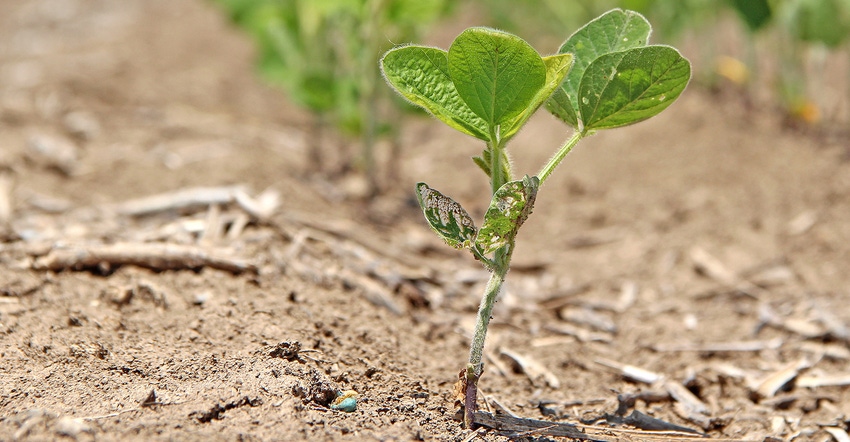
You’ve heard it so often, it’s a mantra: Start clean! For Arkansas consultant Bob Griffin, that means burndown and at-planting herbicide applications are critical. His cotton growers normally burndown in March so they can start planting in April, preferably April 25 through May 10.
“We want to apply our burndown a month before planting,” says Griffin, whose area encompasses central eastern Arkansas. “The earlier we burndown, the smaller weeds will be. But, there is a balancing act — we don’t want to burndown too early, like in February, and come April, we have new weeds. We normally burndown with Roundup, dicamba, and FirstShot, rehip 10 to 14 days later, and later apply our at-planting herbicides.”
The at-planting application is Griffin’s second punch to make sure fields are totally clean. His growers normally apply Gramoxone with their pre-emerge residual herbicide, usually diuron or Cotoran, to control glyphosate-resistant pigweeds and other weeds.
“In Arkansas this year, we can’t apply dicamba during the season, but we still have LibertyLink and Enlist cotton technologies,” he says. “But, no matter which cotton technology trait you use, you have to be clean at planting.”
Getting a good start includes completely servicing the planter before hitting the field, Griffin says. “Make sure the settings are correct, and worn parts are replaced. Start clean — and plant correctly.”
Variety selection critical
This year, variety selection will be more important than ever before, especially with regard to controlling weeds and diseases, says west Texas consultant Mark Scott. “We’ll match individual varieties with individual fields, based on local yield data. And, we’ll look hard at technology traits for weed control, and genetics for disease control.”
Some isolated areas have volunteer dicamba cotton problems, he says. “But, up toward Lubbock we don’t have any volunteer problems. Not many things can control volunteer cotton. In some places, we can cultivate and spray Gramoxone for control. In other areas, we have several strip-tilled fields that can’t really be tilled until the cover crop gets bigger; otherwise, growers will lose the benefits of the cover crop.”
Scott’s growers try to start with a stale seedbed. On most of their minimum-till, they will burndown with 2,4-D and Roundup to terminate a cover crop of wheat, rye, or oats. “Volunteer cotton often lies dormant until you pre-water your planted cotton to get it up, and then here comes some of the volunteer,” he says. “We spray Gramoxone and Caparol at planting. Gramoxone does a good job on volunteer cotton, if you get it small enough — two-leaf cotton. Another option to consider is going in with an Enlist variety where you previously grew a dicamba variety.
“On all of our fields, we use preplant incorporated herbicides. We use yellows and then whites, like Caparol or Direx, at planting, depending on the soil type. Then when cotton is small, we come over the top with Warrant or Dual. If it’s dicamba cotton, we later use dicamba and use a hooded sprayer later in the season.”
Potential disease problems are another factor that Scott’s growers consider in variety selection. “In 2017, bacterial blight cleaned us in some fields. Alternaria leaf spot completely defoliated several fields. We urge growers to select cotton varieties that have maturity and genetics that will help keep them ahead of diseases.”
Match soils, yield goals
South Carolina consultant Tom Smith agrees that variety selection is one of the most important decisions cotton growers will make in 2018. He urges them to choose the best varieties that match the soils and yield goals for their farms.
“Growers can base their decisions on data from state OVT, local company trials, and on-farm experience,” he says. “Making the wrong decision in variety selection can mean the loss of 200 pounds to 400 pounds of lint per acre. In addition to choosing the best genetics for your farm, choose the trait technology for weed and insect management that best fits your needs.”
Smith’s growers planted most of their cotton acreage to dicamba varieties in 2017. “Some area growers also are looking at 2,4-D varieties; several Phytogen varieties have performed very well in university trials, such as PHY 430 W3FE and PHY 440 W3FE. “Additionally, Liberty offers an insurance spray in both dicamba and 2,4-D varieties. We have versatility in our cotton technology traits that enable us to do a fantastic job of controlling resistant Palmer amaranth and other weeds. Treat small pigweeds, around 4 inches or less, for best results.”
Smith reminds growers to participate in the mandatory training that South Carolina requires this year — they must go through auxin (2,4-D and dicamba) training in order to be able to purchase or apply the products.
In addition to choosing varieties that best fit individual fields, he urges growers to implement solid burndown and pre-emerge programs. “Our burndown normally is comprised of Roundup, 2,4-D, and a residual. We want to get our burndown out two to three weeks before planting; we try to start the last week of April.”
Using optimum seeding rates will help growers this year, Smith says. He generally recommends planting 2.5 to 3 seed per row foot. “We also need a seed treatment for early-season insects, diseases, and nematodes. And we have the option of applying AgLogic 15G (aldicarb nematicide/insecticide) in-furrow. We were very pleased with its performance in 2017.”
About the Author(s)
You May Also Like




